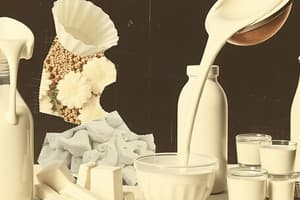Podcast
Questions and Answers
What is the primary role of bacteria in yogurt production?
What is the primary role of bacteria in yogurt production?
- To pasteurize the milk, eliminating harmful microorganisms.
- To add flavor and color to the yogurt.
- To ferment the milk, converting it into yogurt. (correct)
- To increase the milk's fat content.
Why is maintaining a warm temperature important during yogurt production?
Why is maintaining a warm temperature important during yogurt production?
- It helps the yogurt retain its creamy texture.
- It helps the milk solidify faster.
- It prevents the growth of unwanted bacteria.
- It encourages bacterial fermentation. (correct)
Which of the following processes is essential for turning milk into yogurt?
Which of the following processes is essential for turning milk into yogurt?
- Inoculation (correct)
- Refrigeration
- Distillation
- Homogenization
What would happen if the inoculated milk was kept at a cold temperature?
What would happen if the inoculated milk was kept at a cold temperature?
In yogurt production, what is the most important role of the fermentation process?
In yogurt production, what is the most important role of the fermentation process?
Why is the heating step important in yogurt production?
Why is the heating step important in yogurt production?
What crucial role does the cooling stage play after heating the milk?
What crucial role does the cooling stage play after heating the milk?
If the heating step is skipped during yogurt production, what is the potential outcome?
If the heating step is skipped during yogurt production, what is the potential outcome?
What would be the most likely outcome if the milk is not cooled properly after the heating stage?
What would be the most likely outcome if the milk is not cooled properly after the heating stage?
What would happen if the milk was heated to too high a temperature during yogurt production?
What would happen if the milk was heated to too high a temperature during yogurt production?
What is the primary purpose of straining yogurt after fermentation?
What is the primary purpose of straining yogurt after fermentation?
Which of the following bacterial genera is commonly used in the fermentation of milk products?
Which of the following bacterial genera is commonly used in the fermentation of milk products?
Which process primarily defines how fermented milk products are produced?
Which process primarily defines how fermented milk products are produced?
If a yogurt maker decides to skip the straining process, what characteristic of the final product will be most noticeably different?
If a yogurt maker decides to skip the straining process, what characteristic of the final product will be most noticeably different?
A dairy company is looking to develop a new line of fermented milk products. Besides Lactobacillus, which other bacteria would be most appropriate to consider for achieving a diverse range of flavor profiles?
A dairy company is looking to develop a new line of fermented milk products. Besides Lactobacillus, which other bacteria would be most appropriate to consider for achieving a diverse range of flavor profiles?
Why are various Lactobacilli strains cultivated in laboratories?
Why are various Lactobacilli strains cultivated in laboratories?
What is the primary outcome of growing different Lactobacilli strains?
What is the primary outcome of growing different Lactobacilli strains?
How does laboratory cultivation of Lactobacilli strains impact the dairy industry?
How does laboratory cultivation of Lactobacilli strains impact the dairy industry?
A dairy company wants to introduce a novel yogurt flavor. How could the knowledge of Lactobacilli strains assist them?
A dairy company wants to introduce a novel yogurt flavor. How could the knowledge of Lactobacilli strains assist them?
What is required to achieve the creation of cultured milk products with specific flavors and textures?
What is required to achieve the creation of cultured milk products with specific flavors and textures?
Which of the following products involves the process of culturing milk?
Which of the following products involves the process of culturing milk?
If a consumer is looking for a dairy product that contains live and active cultures, which of these options would be the MOST suitable?
If a consumer is looking for a dairy product that contains live and active cultures, which of these options would be the MOST suitable?
To create a specific type of hard cheese, a dairy farmer performs several steps. Which of the following steps is MOST crucial in differentiating a cultured hard cheese from regular milk?
To create a specific type of hard cheese, a dairy farmer performs several steps. Which of the following steps is MOST crucial in differentiating a cultured hard cheese from regular milk?
Why does the yogurt-making process naturally prevent the growth of harmful microorganisms?
Why does the yogurt-making process naturally prevent the growth of harmful microorganisms?
A food scientist is experimenting with different methods of producing cultured milk products. Which variable would MOST directly affect the final product's flavor and texture?
A food scientist is experimenting with different methods of producing cultured milk products. Which variable would MOST directly affect the final product's flavor and texture?
In home food preservation, what critical control measure mirrors a key safety aspect of yogurt production?
In home food preservation, what critical control measure mirrors a key safety aspect of yogurt production?
A small dairy farm wants to diversify its product line by introducing a new cultured milk product. Considering equipment costs and required expertise, which product would likely be the MOST accessible and cost-effective to start producing?
A small dairy farm wants to diversify its product line by introducing a new cultured milk product. Considering equipment costs and required expertise, which product would likely be the MOST accessible and cost-effective to start producing?
A yogurt manufacturer discovers a batch contaminated with a harmful microorganism that thrives in acidic environments. Which adjustment would best address this specific issue?
A yogurt manufacturer discovers a batch contaminated with a harmful microorganism that thrives in acidic environments. Which adjustment would best address this specific issue?
Which practice most directly compromises the inherent safety mechanisms of yogurt production?
Which practice most directly compromises the inherent safety mechanisms of yogurt production?
How might altering the standard yogurt-making procedure impact the final product's safety?
How might altering the standard yogurt-making procedure impact the final product's safety?
Flashcards
Heating Milk (Yogurt)
Heating Milk (Yogurt)
A step in yogurt making crucial for consistency and killing bad bacteria.
Cooling Milk (Yogurt)
Cooling Milk (Yogurt)
The process of reducing milk temperature after heating to allow good bacteria to thrive.
Beneficial Microorganisms
Beneficial Microorganisms
Bacteria that benefit the yogurt-making process.
Survival Temperature
Survival Temperature
Signup and view all the flashcards
Yogurt Consistency
Yogurt Consistency
Signup and view all the flashcards
Milk Fermentation
Milk Fermentation
Signup and view all the flashcards
Yogurt Bacteria
Yogurt Bacteria
Signup and view all the flashcards
Milk Inoculation
Milk Inoculation
Signup and view all the flashcards
Warmth and Yogurt
Warmth and Yogurt
Signup and view all the flashcards
Fermentation Time
Fermentation Time
Signup and view all the flashcards
Yogurt Safety
Yogurt Safety
Signup and view all the flashcards
Acidity
Acidity
Signup and view all the flashcards
Heat
Heat
Signup and view all the flashcards
Harmful Microorganisms
Harmful Microorganisms
Signup and view all the flashcards
Combined Effects
Combined Effects
Signup and view all the flashcards
Straining Yogurt
Straining Yogurt
Signup and view all the flashcards
Fermented Milk Products
Fermented Milk Products
Signup and view all the flashcards
Lactic Acid Bacteria
Lactic Acid Bacteria
Signup and view all the flashcards
Lactobacillus
Lactobacillus
Signup and view all the flashcards
Lactococcus
Lactococcus
Signup and view all the flashcards
Cultured fermentation
Cultured fermentation
Signup and view all the flashcards
Cultured milk products
Cultured milk products
Signup and view all the flashcards
Bacterial strains
Bacterial strains
Signup and view all the flashcards
Flavor diversity
Flavor diversity
Signup and view all the flashcards
Yogurt
Yogurt
Signup and view all the flashcards
Kefir
Kefir
Signup and view all the flashcards
Other Cultured Dairy Foods
Other Cultured Dairy Foods
Signup and view all the flashcards
Ice Cream
Ice Cream
Signup and view all the flashcards
Study Notes
- Yogurt is made through bacterial fermentation of milk, utilizing yogurt cultures.
- Bacteria ferments lactose, yielding lactic acid, which interacts with milk proteins to produce yogurt's texture and tart flavor.
- Commonly, yogurt is made using cow's milk; however, can also be made using milk from buffalo, goats, mares, or camels.
Yogurt Production
- Yogurt production involves using a culture of Lactobacillus delbrueckii subsp. bulgaricus and Streptococcus thermophilus bacteria.
- Other Lactobacilli and Bifidobacteria are sometimes introduced during or after culturing.
- The first step is to heat the milk to around 85 °C (185 °F) to denature its proteins, crucial for yogurt's consistency and to eliminate harmful bacteria.
- After heating, let the milk cool to around 50 °C (122 °F) or slightly lower, so beneficial microorganisms can survive.
- The milk is inoculated with specific bacterial cultures, typically Streptococcus thermophilus and Lactobacillus bulgaricus, which are vital for turning milk into yogurt.
- For fermentation, the inoculated milk needs to kept warm for several hours, so the bacteria can ferment the milk.
- Lactic acid, produced during this process, thickens the milk, giving yogurt its tangy taste.
- For a firmer yogurt, dried milk can be added before fermentation in order to achieve higher concentrations of solids.
- The combination of heat and acidity naturally inhibits harmful microorganisms.
- Straining is also an option, and helps remove excess whey, resulting in a thicker texture.
Fermented Milk Products
- These dairy foods have been fermented with lactic acid bacteria like Lactobacillus, Lactococcus, and Leuconostoc.
- Fermentation enhances taste, improves digestibility, and extends product shelf-life
- Lactobacilli strains are grown in labs, allowing for flavors and characteristics in cultured milk products.
Kefir
-
Kefir is a fermented milk drink.
-
Kefir/kephir is similar to a thin yogurt, with a symbiotic mesophilic culture from kefir grains.
-
Kefir grains is a symbiotic matrix of bacteria and yeasts
-
Traditional kefir ferments at ambient temperatures, usually overnight.
-
Fermentation of lactose produces a sour, carbonated, slightly alcoholic beverage.
-
The kefir grains that initiate this are a symbiotic culture of lactic acid bacteria and yeasts, which are embedded in a matrix of proteins, lipids, and polysaccharides.
-
The microbial activity forms the matrix, resembling cauliflower grains (القرنبيط).
-
Kefir grains have a color white to creamy yellow.
-
The grains contain a complex and variable community, that can include lactic acid bacteria, acetic acid bacteria, and yeasts.
-
During fermentation, lactose gets broken down mostly to lactic acid (25%), This acidifies the product.
Kombucha
- Kombucha—a fermented tea beverage made by sweetening black or green tea; fermenting it with a SCOBY a symbiotic culture of bacteria and yeast.
- Microbial populations in SCOBY cultures vary, but yeast is a key component
- Bacterial component includes Gluconacetobacter xylinus, this oxidizes yeast-produced alcohols into acetic and other acids.
- Its made by putting the kombucha culture into a broth of sugared tea.
- Kombucha tea made with less sugar may be unappealing.
- Sucrose turns biochemically into fructose, which turns into glucose, then to gluconic and acetic acid.
- Kombucha contains enzymes, amino acids, polyphenols, ethanol, glucuronic acid, glycerol, lactic acid, usnic acid (a hepatotoxin), and B-vitamins, and vitamin C.
- Kombucha is usually less than 1% alcohol, It increases with fermentation time.
- Over-fermentation generates high amounts of acids similar to vinegar.
- Kombucha culture, when dried, becomes a leather-like textile known as a microbial cellulose, which can be molded onto forms to create seamless clothing (ملابس خاليه من الخياطه).
- Using different broth media such as coffee, black tea, and green tea to grow the kombucha culture results in different textile colors,
- The textile's feel and texture is changed by the growth media and dyes.
Studying That Suits You
Use AI to generate personalized quizzes and flashcards to suit your learning preferences.




